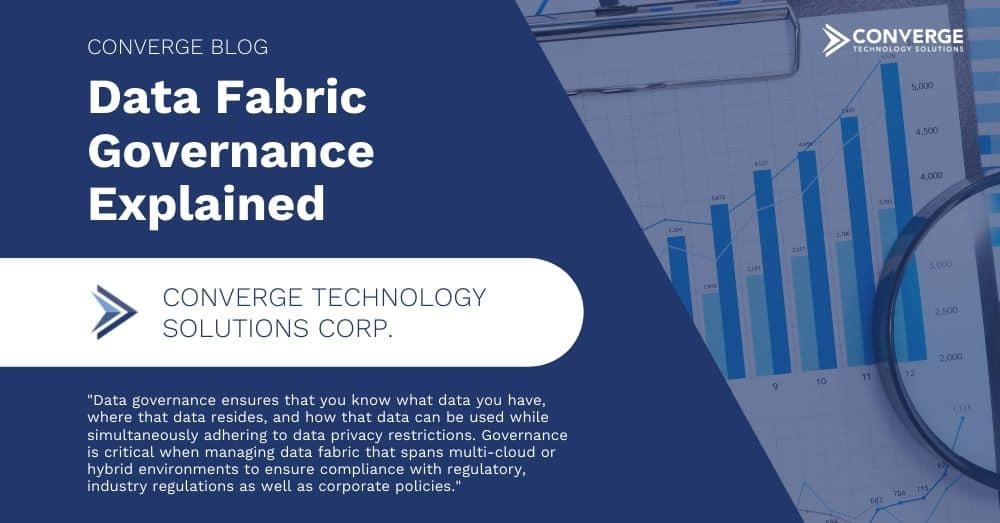Data governance is essential to an organization’s overall data management strategy and a key component in any Data Ops implementation.
Data governance ensures that you know what data you have, where that data resides, and how that data can be used while simultaneously adhering to data privacy restrictions. Governance is critical when managing data fabric that spans multi-cloud or hybrid environments to ensure compliance with regulatory, industry regulations as well as corporate policies.
Why Is Data Fabric Governance Important?
Data fabric pulls all your data resources together regardless of where they reside. A reliable data fabric eliminates data silos and disconnected architecture by creating a unified infrastructure to ensure consistency. Regardless of where your data lives, you can manage and monitor costs, performance, and efficiency.
Not only does data fabric improve your end-to-end performance and control costs, it simplifies your configurations and management.
When it comes to unifying governance and assuring compliance, data fabric:
- Allows for local management and governance of metadata while supporting a global unified view and policy enforcement
- Automatically applies policies on data assets per global and local rules
- Utilizes advanced capabilities to automate data asset classification and curation
- Automatically establishes query-able access routes for cataloged assets
Data fabric allows you to automate data governance and security by deploying an active governance layer, which reduces your compliance and regulatory risk by applying automatic policy protection and compliance.
Governance Layer
Along with other security and compliance tasks, an IBM Cloud Pak for Data governance layer will:
- Catalog and curate metadata
- Define data policies for privacy
- Curate data
- Capture data lineage
Because the data governance layer understands the data format and the data significance, it can apply the right policy for every piece of data as well as every authorized user. For example, the governance layer understands whether data is structured or unstructured, or whether it’s public or protected data.
Instead of having to manually apply rules, an integrated governance platform applies rules at an organizational level which propagates through data sets as needed. Because analytic models in different tools can talk to each other, this allows data policy enforcement at a granular level, which can then be largely automated.
IBM Cloud Pak for Data enables a unified, end-to-end solution throughout the data lifecycle, so you can configure and run any aspect of your data platform while in production.
Intelligent Integration
A data governance layer allows intelligent integration without any security or compliance concerns.
Intelligent integration can accelerate your tasks with automated flow and pipeline creation even across distributed data sources. It allows for self-service data ingestion and access while providing both local and global enforcement policies for compliance.
Intelligent integration creates a best-case scenario for data utilization by automatically determining the best fit for execution, workload distribution, and self-tuning for optimized performance. Intelligent integration also enables the composition, testing, operation, and monitoring of data pipelines for better orchestration and lifecycle management.
The Top 3 Benefits of a Data Fabric
Data is more dispersed than ever. Data is also more dynamic and diverse. Multi-vendor, multi-cloud, and hybrid environments on top of legacy infrastructures that grow over time continue to add to the complexity of data handling.
Data fabric enables data scientists and other users to optimize data usage in three distinct ways:
1. Self-Service Data Consumption and Collaboration
Self-service data consumption allows data users to find data faster and spend more time actually working with data rather than hunting for it and authenticating it.
Speed is an important benefit, especially when you’re working with vast data sets in a distributed workplace. According to Gartner’s Magic Quadrant for Data Integration Tools, organizations deploying data fabric for dynamic connection, optimization, and automation of data management processes by 2023 will reduce the time to integrated data delivery by nearly a third.
2. Automate Governance, Data Protection, and Security
With AI-enhanced automation, you can create governance definitions and rules by automatically extracting content from regulatory documents. AI enhanced automation simplifies your governance process, especially when there are changes or updates to governance regulations or policies. You can apply changes automatically with speed and precision. Compliance is ensured. Data prep, data cleansing and data governance is all done from the same tool.
3. Automate Data Engineering Tasks
Data delivery can be optimized and accelerated by eliminating repetitive, manual, and inefficient data integration processes reducing errors and providing continuous real time data delivery.
Data engineers using IBM Cloud Pak for Data can run integration workloads on most execution engines and push execution to where data resides using runtime as a service. The interoperability between batch, virtual, API, and streaming modes creates optimal flexibility for data engineers and allows data scientists to work with speed within a single platform.
Automating data engineering and augmenting your data integration can reduce Extract, Transform, Load (ETL) requests by between 25% and 65%.
Our Advanced Analytics team is eager to work with your organization through data governance initiatives. Reach out today: [email protected]





